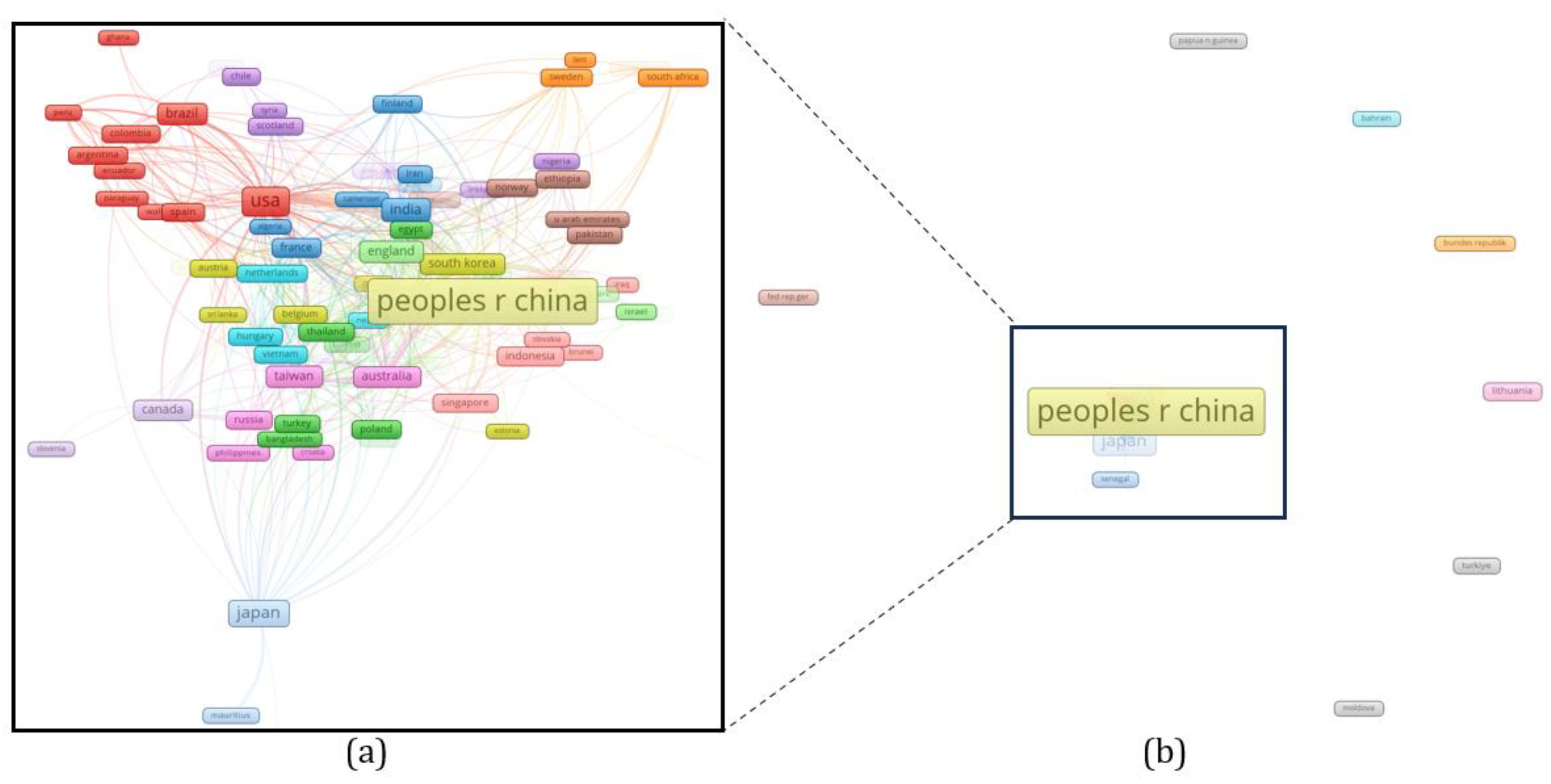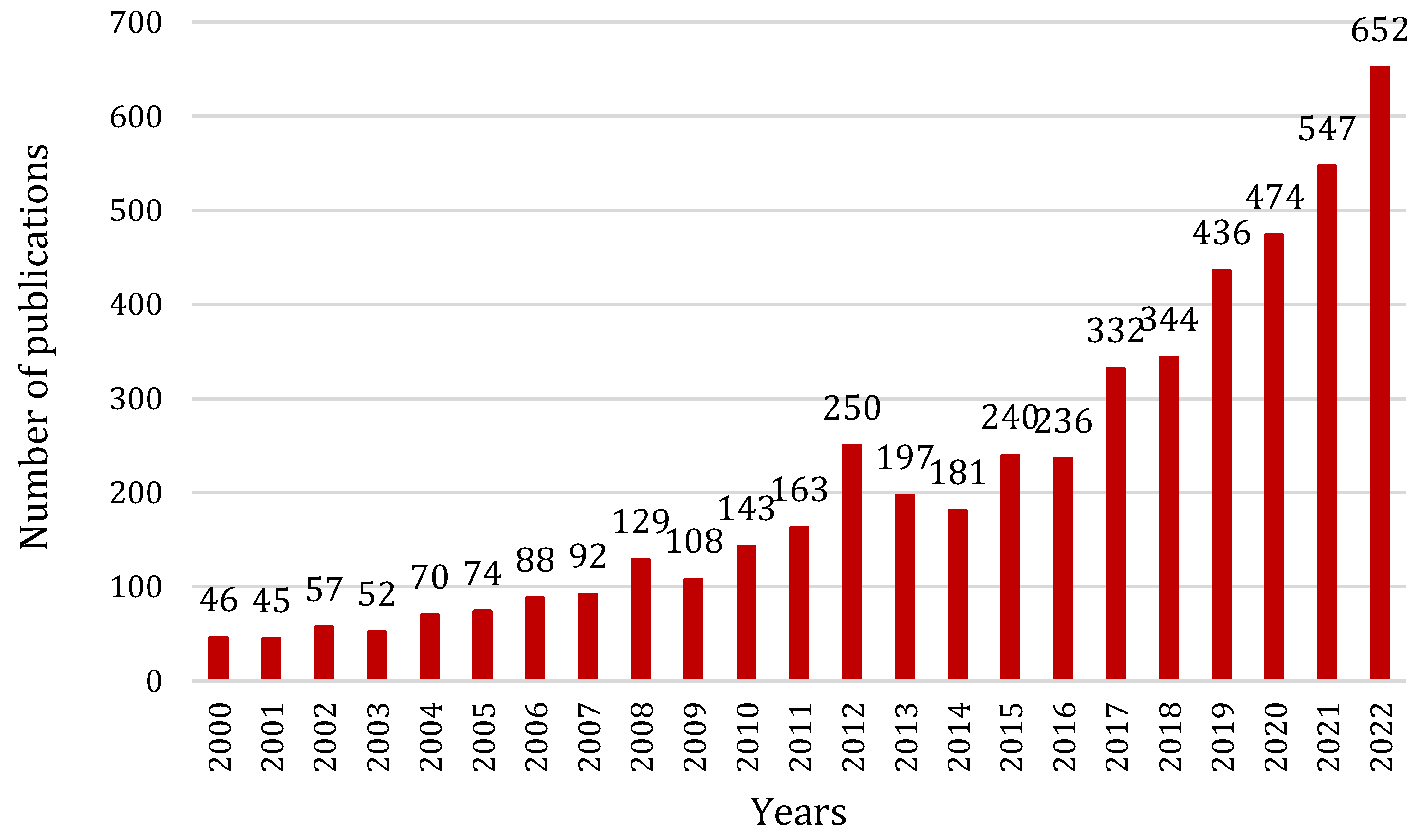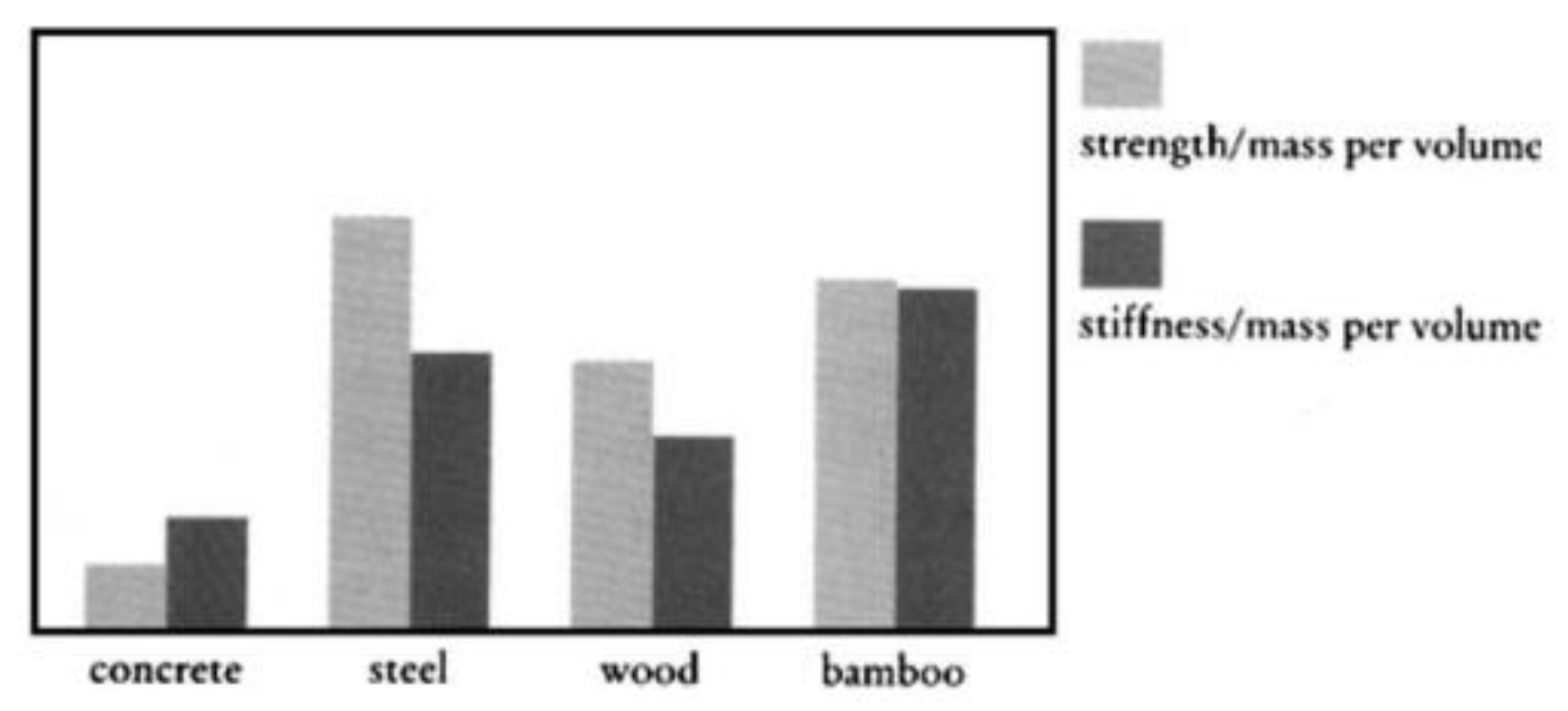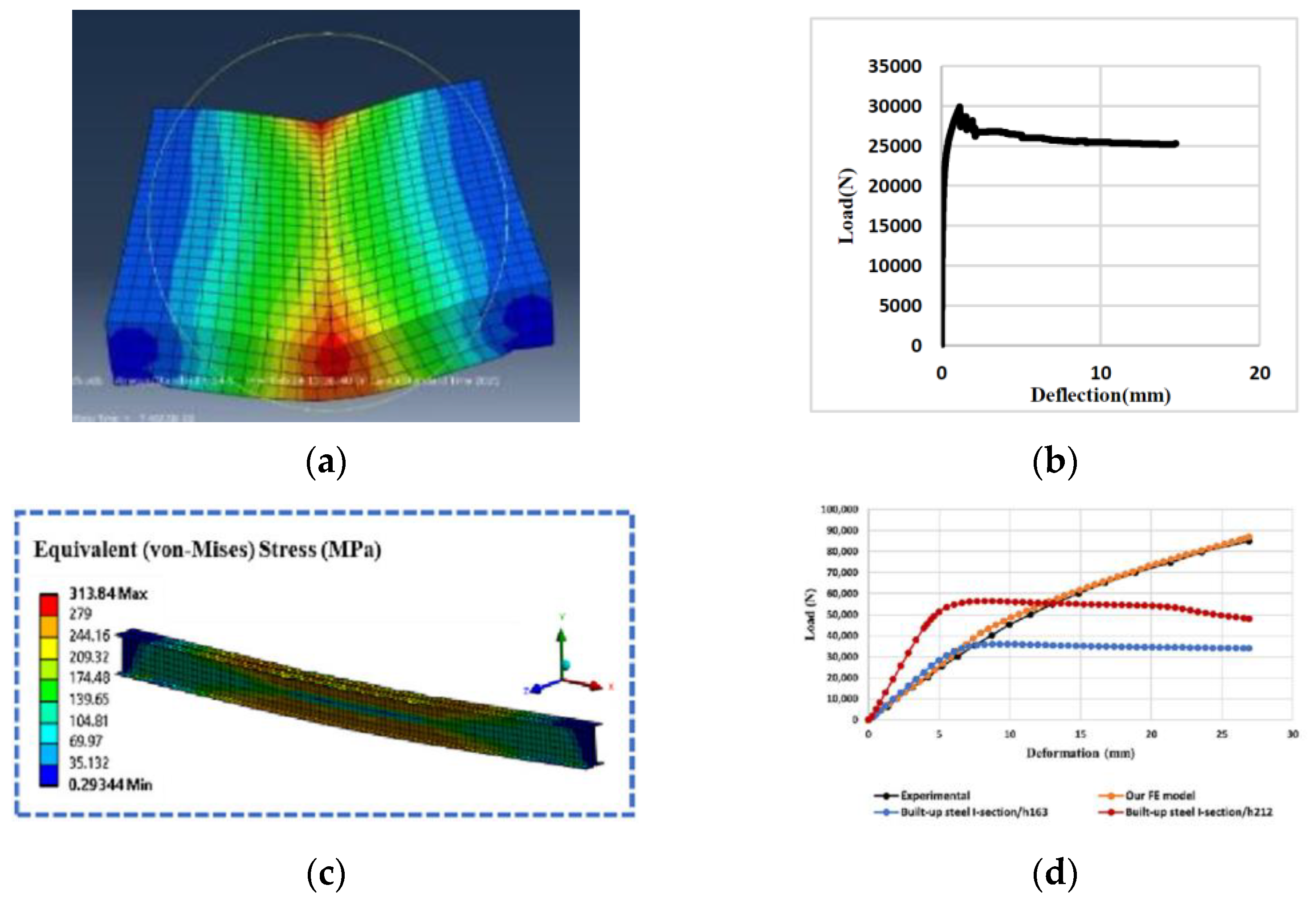The Application of Bamboo in the Railway Industry: A Sustainable Solution for Track Construction
Abstract
:1. Introduction
1.1. Versatility and Durability
1.2. Low Embodied Energy and Carbon Footprint
1.3. Lightweight and Easy to Handle
1.4. Bamboo Life Cycle Assessment
1.5. Limitations
1.6. Current Number of Research about Bamboo
1.7. Paper Outline
2. Bamboo Construction Material Fabrication
2.1. Bamboo Structure
2.2. Bamboo Mechanical Properties
2.3. Bamboo Plywood
2.4. Bamboo Scrimber Fabrication
3. Application of Bamboo in the Railway Industry
3.1. Background
3.2. Numerical Modeling
3.3. Bamboo Sleeper Production
3.3.1. Background
3.3.2. Bamboo Sleeper Application Challenges
4. Future Prospects and Discussion
5. Conclusions
- Bamboo has been considered a low-quality product for construction by emerging new technologies to manufacture bamboo products such as plywood, bamboo scrimber, and laminates. This material provides better properties than wood and composites with high stiffness, strength/mass per volume, and low carbon emission features.
- More than 104 countries have contributed to bamboo publications with around 4119 papers. These contributions have increased in recent years, which shows the attention given by researchers even in those countries without bamboo as a local plant.
- One of the main defects regarding the application of bamboo is the wide range of properties that can be found in the same bamboo products. However, the mechanical properties of bamboo products greatly increase, but the high difference between the mechanical properties of the elements of the structures may cause failure.
- Bamboo plywood and scrimber are the main products that are suitable for railway sleeper production in terms of their durability and mechanical performance. These products can provide moisture-proofing, water resistance, corrosion resistance, and resistance to salt damage.
- The application of bamboo in the railway industry has not been well extended compared with other parts of structural science. This material has mostly been used for soil improvement. However, considering its properties, it has the potential to be widely used in railway sleeper manufacturing, as has been studied so far. The shortcoming for more application of bamboo in the railway industry is the concerns about its weathering and long-term performance, as there are no such studies.
- To model bamboo, it is mostly characterized as an anisotropic material, with greater tensile and compressive strengths in the longitudinal direction compared to the transverse directions. The literature has proven that most FEM models can be validated with experimental results with low differences.
Author Contributions
Funding
Institutional Review Board Statement
Informed Consent Statement
Data Availability Statement
Acknowledgments
Conflicts of Interest
References
- Siahkouhi, M.; Li, X.; Han, X.; Jing, G. Improving the mechanical performance of timber railway sleepers with carbon fabric reinforcement: An experimental and numerical study. J. Compos. Constr. 2022, 26, 04021064. [Google Scholar] [CrossRef]
- Maulana, M.I.; Jeon, W.S.; Purusatama, B.D.; Kim, J.H.; Prasetia, D.; Yang, G.U.; Savero, A.M.; Nawawi, D.S.; Nikmatin, S.; Sari, R.K. Anatomical Characteristics for Identification and Quality Indices of Four Promising Commercial Bamboo Species in Java, Indonesia. BioResources 2022, 17, 1442–1453. [Google Scholar] [CrossRef]
- Yang, S.; Li, H.; Fei, B.; Zhang, X.; Wang, X. Bond quality and durability of cross-laminated flattened bamboo and timber (CLBT). Forests 2022, 13, 1271. [Google Scholar] [CrossRef]
- Rathour, R.; Kumar, H.; Prasad, K.; Anerao, P.; Kumar, M.; Kapley, A.; Pandey, A.; Kumar Awasthi, M.; Singh, L. Multifunctional applications of bamboo crop beyond environmental management: An Indian prospective. Bioengineered 2022, 13, 8893–8914. [Google Scholar] [CrossRef] [PubMed]
- Pamungkas, D.; Prasetyo, B.D.; Roshetko, J.M.; Sabastian, G.E.; Indartik, I.; Suryandari, E.Y.; Ekawati, D.; Ingram, W. Growth, yield and economic potential of Strobilanthes cusia (Nees) Kuntze in underutilized bamboo stands in Indonesia. Agrofor. Syst. 2023, 97, 1491–1509. [Google Scholar] [CrossRef]
- Dlamini, L.C.; Fakudze, S.; Makombe, G.G.; Muse, S.; Zhu, J. Bamboo as a valuable resource and its utilization in historical and modern-day China. BioResources 2022, 17, 1926. [Google Scholar] [CrossRef]
- Khong, S.; Yee, J.; Doh, S.; Chin, S. A review of agro-potential waste’s as constituent in railway sleepers. Phys. Chem. Earth Parts A/B/C 2022, 128, 103238. [Google Scholar] [CrossRef]
- Chaturvedi, K.; Singhwane, A.; Dhangar, M.; Mili, M.; Gorhae, N.; Naik, A.; Prashant, N.; Srivastava, A.; Verma, S. Bamboo for producing charcoal and biochar for versatile applications. Biomass Convers. Biorefinery 2023, 1–27. [Google Scholar] [CrossRef]
- Sharma, B.; van der Vegte, A. Engineered bamboo for structural applications. In Nonconventional and Vernacular Construction Materials; Elsevier: Amsterdam, The Netherlands, 2020; pp. 597–623. [Google Scholar]
- Jain, S.; Kumar, R.; Jindal, U. Mechanical behaviour of bamboo and bamboo composite. J. Mater. Sci. 1992, 27, 4598–4604. [Google Scholar] [CrossRef]
- Adin, H.; Adin, M.Ş. Effect of particles on tensile and bending properties of jute epoxy composites. Mater. Test. 2022, 64, 401–411. [Google Scholar] [CrossRef]
- Garcia-Saenz, M. Social and cultural aspects of constructions with bamboo. In Proceedings of the Tenth LACCEI Latin American and Caribbean Conference, Panama City, Panama, 23–25 July 2012. [Google Scholar]
- Waite, M. Sustainable Textiles: The Role of Bamboo and a Comparison of Bamboo Textile Properties—Part 2. J. Text. Appar. Technol. Manag. 2010, 6. [Google Scholar]
- van Dam, J.E.; Elbersen, H.W.; Montaño, C.M.D. Bamboo production for industrial utilization. In Perennial Grasses for Bioenergy and Bioproducts; Academic Press: Cambridge, MA, USA, 2018; pp. 175–216. [Google Scholar] [CrossRef]
- Lakkad, S.; Patel, J. Mechanical properties of bamboo, a natural composite. Fibre Sci. Technol. 1981, 14, 319–322. [Google Scholar] [CrossRef]
- Jia, B.; Yu, Q.; Zhao, Y.; Qin, M.; Wang, W.; Liu, Z.; Lao, C.Y.; Liu, Y.; Wu, H.; Zhang, Z. Bamboo-like hollow tubes with MoS2/N-doped-C interfaces boost potassium-ion storage. Adv. Funct. Mater. 2018, 28, 1803409. [Google Scholar] [CrossRef]
- Han, S.; Chen, F.; Ye, H.; Zheng, Z.; Chen, L.; Wang, G. Bamboo-Inspired Renewable, High-Strength, Vibration-Damping Composites for Structural Applications. ACS Sustain. Chem. Eng. 2023, 11, 1146–1156. [Google Scholar] [CrossRef]
- Wei, X.; Zhou, H.; Chen, F.; Wang, G. Bending flexibility of moso bamboo (Phyllostachys edulis) with functionally graded structure. Materials 2019, 12, 2007. [Google Scholar] [CrossRef] [PubMed]
- Isa, A.; Minamino, J.; Mizuno, H.; Suzuki, S.; Kojima, Y.; Ito, H.; Makise, R.; Okamoto, M.; Hasegawa, T. Increased water resistance of bamboo flour/polyethylene composites. J. Wood Chem. Technol. 2013, 33, 208–216. [Google Scholar] [CrossRef]
- Ding, T.; Zhou, J.; Wan, D.; Chen, Z.; Wang, C.; Zhang, F. Silicon isotope fractionation in bamboo and its significance to the biogeochemical cycle of silicon. Geochim. Cosmochim. Acta 2008, 72, 1381–1395. [Google Scholar] [CrossRef]
- Norhisham, A.; Faizah, A.; Zaidon, A. Effects of moisture content on the bamboo borer Dinoderus minutus . J. Trop. For. Sci. 2015, 27, 334–341. [Google Scholar]
- Van Der Lugt, P.; Van den Dobbelsteen, A.; Abrahams, R. Bamboo as a building material alternative for Western Europe? A study of the environmental performance, costs and bottlenecks of the use of bamboo (products) in Western Europe. J. Bamboo Ratt. 2003, 2, 205–223. [Google Scholar] [CrossRef]
- Nie, Y.; Ping, R.; Ji, C.; Li, L.; Bao, L.; Peng, J.; Li, X. Achieving superior high-life-stability and stable structure for flexible fiber electrodes inspired by Bamboo rice dumpling. Electrochim. Acta 2023, 452, 142352. [Google Scholar] [CrossRef]
- Emamverdian, A.; Ding, Y.; Ranaei, F.; Ahmad, Z. Application of bamboo plants in nine aspects. Sci. World J. 2020, 2020, 7284203. [Google Scholar] [CrossRef] [PubMed]
- Shah, K.N.A.K.A.; Yusop, M.Z.M.; Rohani, J.M.; Fadil, N.A.; Manaf, N.A.; Hartono, B.; Tuyen, N.D.; Masaki, T.; Ahmad, A.S.; Ramli, A. Feasibility study on biomass bamboo renewable energy in Malaysia, Indonesia, Vietnam and Japan. Chem. Eng. Trans. 2021, 89, 127–132. [Google Scholar]
- Finkbeiner, M.; Inaba, A.; Tan, R.; Christiansen, K.; Klüppel, H.-J. The new international standards for life cycle assessment: ISO 14040 and ISO 14044. Int. J. Life Cycle Assess. 2006, 11, 80–85. [Google Scholar] [CrossRef]
- Xu, X.; Xu, P.; Zhu, J.; Li, H.; Xiong, Z. Bamboo construction materials: Carbon storage and potential to reduce associated CO2 emissions. Sci. Total Environ. 2022, 814, 152697. [Google Scholar] [CrossRef] [PubMed]
- Li, Y.; Shen, H.; Shan, W.; Han, T. Flexural behavior of lightweight bamboo–steel composite slabs. Thin-Walled Struct. 2012, 53, 83–90. [Google Scholar] [CrossRef]
- Zhang, Z.; Zhang, L.; Song, B.; Yao, Y.; Shi, Y. Bamboo-inspired, simulation-guided design and 3D printing of light-weight and high-strength mechanical metamaterials. Appl. Mater. Today 2022, 26, 101268. [Google Scholar] [CrossRef]
- Shao, Z.; Zhou, L.; Liu, Y.; Wu, Z.; Arnaud, C. Differences in structure and strength between internode and node sections of moso bamboo. J. Trop. For. Sci. 2010, 22, 133–138. [Google Scholar]
- Dauletbek, A.; Xue, X.; Shen, X.; Li, H.; Feng, Z.; Lorenzo, R.; Liu, K.; Escamilla, E.Z.; Yao, L.; Zheng, X. Lightweight bamboo structures-Report on 2021 International Collaboration on Bamboo Construction. Sustain. Struct. 2022, 3, 25. [Google Scholar] [CrossRef]
- Chaowana, K.; Wisadsatorn, S.; Chaowana, P. Bamboo as a sustainable building material—Culm characteristics and properties. Sustainability 2021, 13, 7376. [Google Scholar] [CrossRef]
- Mahdavi, M.; Clouston, P.; Arwade, S. Development of laminated bamboo lumber: Review of processing, performance, and economical considerations. J. Mater. Civ. Eng. 2011, 23, 1036–1042. [Google Scholar] [CrossRef]
- Arcos, P.; Tintín, K.; Calvo, J.; Avila, E.B. Golden Flower: Architectural Design Based on Bamboo Structure. Available online: https://www.researchgate.net/profile/Enrique-Barreno-Avila/publication/359109569_Golden_Flower_Architectural_design_based_on_bamboo_structure/links/63d67d86c97bd76a8246cda6/Golden-Flower-Architectural-design-based-on-bamboo-structure.pdf (accessed on 1 October 2023).
- Liu, Y.; Zhang, J.; Xu, J.; Wang, Y.; Li, B.; Zhang, S. Carbon emission-based life cycle assessment of rural residential buildings constructed with engineering bamboo: A case study in China. J. Build. Eng. 2023, 76, 107182. [Google Scholar] [CrossRef]
- Chen, X.; Chen, F.; Yang, Q.; Gong, W.; Wang, J.; Li, Y.; Wang, G. An environmental food packaging material part I: A case study of life-cycle assessment (LCA) for bamboo fiber environmental tableware. Ind. Crops Prod. 2023, 194, 116279. [Google Scholar] [CrossRef]
- Finnveden, G.; Hauschild, M.Z.; Ekvall, T.; Guinée, J.; Heijungs, R.; Hellweg, S.; Koehler, A.; Pennington, D.; Suh, S. Recent developments in life cycle assessment. J. Environ. Manag. 2009, 91, 1–21. [Google Scholar] [CrossRef] [PubMed]
- Gan, J.; Chen, M.; Semple, K.; Liu, X.; Dai, C.; Tu, Q. Life cycle assessment of bamboo products: Review and harmonization. Sci. Total Environ. 2022, 849, 157937. [Google Scholar] [CrossRef]
- Zea Escamilla, E.; Habert, G.; Correal Daza, J.F.; Archilla, H.F.; Echeverry Fernández, J.S.; Trujillo, D. Industrial or traditional bamboo construction? Comparative life cycle assessment (LCA) of bamboo-based buildings. Sustainability 2018, 10, 3096. [Google Scholar] [CrossRef]
- Chang, F.-C.; Chen, K.-S.; Yang, P.-Y.; Ko, C.-H. Environmental benefit of utilizing bamboo material based on life cycle assessment. J. Clean. Prod. 2018, 204, 60–69. [Google Scholar] [CrossRef]
- Vogtländer, J.G.; van der Velden, N.M.; van der Lugt, P. Carbon sequestration in LCA, a proposal for a new approach based on the global carbon cycle; cases on wood and on bamboo. Int. J. Life Cycle Assess. 2014, 19, 13–23. [Google Scholar] [CrossRef]
- Ogawa, K.; Hirogaki, T.; Aoyama, E.; Taniguchi, M.; Ogawa, S. Sustainable Manufacturing System Focusing on the Natural Growth of Bamboo (Evaluation of Environmental Impact by LCA). J. Adv. Mech. Des. Syst. Manuf. 2010, 4, 531–542. [Google Scholar] [CrossRef]
- Vogtländer, J.; Van der Lugt, P.; Brezet, H. The sustainability of bamboo products for local and Western European applications. LCAs and land-use. J. Clean. Prod. 2010, 18, 1260–1269. [Google Scholar] [CrossRef]
- Caldas, L.; da Gloria, M.; Santos, D.; Andreola, V.; Pepe, M.; Toledo Filho, R. Carbon footprint of bamboo particles, rice husk and wood shavings-cement composites. Acad. J. Civ. Eng. 2017, 35, 499–506. [Google Scholar]
- Zhang, S.; Li, Y.; Singh, B.P.; Wang, H.; Cai, X.; Chen, J.; Qin, H.; Li, Y.; Chang, S.X. Contrasting short-term responses of soil heterotrophic and autotrophic respiration to biochar-based and chemical fertilizers in a subtropical Moso bamboo plantation. Appl. Soil Ecol. 2021, 157, 103758. [Google Scholar] [CrossRef]
- Harries, K.A.; Bumstead, J.; Richard, M.; Trujillo, D. Geometric and material effects on bamboo buckling behaviour. Proc. Inst. Civ. Eng.-Struct. Build. 2017, 170, 236–249. [Google Scholar] [CrossRef]
- Wang, J.; Siahkouhi, M.; Astaraki, F.; Uuganbayar, S.; Jing, G.; Movahedi Rad, M. Modification of Concrete Railway Sleeper Mix Design, Using a Hybrid Application of Steel Fibers. Acta Polytech. Hung. 2022, 19, 119–130. [Google Scholar] [CrossRef]
- Das, M.; Chakraborty, D. Evaluation of improvement of physical and mechanical properties of bamboo fibers due to alkali treatment. J. Appl. Polym. Sci. 2008, 107, 522–527. [Google Scholar] [CrossRef]
- Xiansheng, Q.; Feng, H.; Qiong, L.; Xin, S. Online defect inspection algorithm of bamboo strip based on computer vision. In Proceedings of the 2009 IEEE International Conference on Industrial Technology, Churchill, VIC, Australia, 10–13 February 2009; pp. 1–5. [Google Scholar]
- Satyanarayana, K.; Sukumaran, K.; Mukherjee, P.; Pavithran, C.; Pillai, S. Natural fibre-polymer composites. Cem. Concr. Compos. 1990, 12, 117–136. [Google Scholar] [CrossRef]
- Yuan, T.; Wang, X.; Lou, Z.; Zhang, T.; Han, X.; Wang, Z.; Hao, X.; Li, Y. Comparison of the fabrication process and macro and micro properties of two types of crack-free, flatten bamboo board. Constr. Build. Mater. 2022, 317, 125949. [Google Scholar] [CrossRef]
- Composite Plybamboo Form with Steel Frame. Available online: https://www.gbstandards.org/China_standard_english.asp?code=JG/T%20428-2014&id=86051 (accessed on 1 October 2023).
- Quality Grading Standards of Main Bamboo Shoot. Available online: https://www.chinesestandard.net/PDF.aspx/GBT30762-2014 (accessed on 1 October 2023).
- Testing Methods for Physical and Mechanical Properties of Bamboo Used in Building. Available online: https://www.chinesestandard.net/PDF/English.aspx/JGT199-2007 (accessed on 1 October 2023).
- Bamboos . Available online: https://www.chinesestandard.net/PDF/English.aspx/GBT2690-1981 (accessed on 1 October 2023).
- Testing Methods for Physical and Mechanical Properties of Bamboos . Available online: https://www.chinesestandard.net/PDF/English.aspx/GBT15780-1995 (accessed on 1 October 2023).
- Amede, E.A.; Hailemariama, E.K.; Hailemariam, L.M.; Nuramo, D.A. A review of codes and standards for bamboo structural design. Adv. Mater. Sci. Eng. 2021, 2021, 4788381. [Google Scholar] [CrossRef]
- Yu, Y.; Zhu, R.; Wu, B.; Hu, Y.a.; Yu, W. Fabrication, material properties, and application of bamboo scrimber. Wood Sci. Technol. 2015, 49, 83–98. [Google Scholar] [CrossRef]
- Van Hung, T.; Lien, H.D.; Antonov, S. A Design of Bamboo Plywood Pressing Machine. VNUHCM J. Eng. Technol. 2019, 3, SI143–SI150. [Google Scholar]
- Shen-xue, J.; Qi-sheng, Z.; Shu-hai, J. On Structure, production, and market of bamboo-based panels in China. J. For. Res. 2002, 13, 151–156. [Google Scholar] [CrossRef]
- Dauletbek, A.; Li, H.; Xiong, Z.; Lorenzo, R. A review of mechanical behavior of structural laminated bamboo lumber. Sustain. Struct. 2021, 1, 4. [Google Scholar] [CrossRef]
- Rathod, S.; Parab, A.; Tamkhane, A.; Neharkar, A.; Patil, A.; Gayake, P. A Comparative Study of Bamboo Reinforced Vs Steel Reinforced Concrete Structure. Int. J. Res. Appl. Sci. Eng. Technol. (IJRASET) 2022, 10, 973–976. [Google Scholar] [CrossRef]
- Van der Lugt, P.; Van den Dobbelsteen, A.; Janssen, J. An environmental, economic and practical assessment of bamboo as a building material for supporting structures. Constr. Build. Mater. 2006, 20, 648–656. [Google Scholar] [CrossRef]
- Sun, H.; Li, H.; Dauletbek, A.; Lorenzo, R.; Corbi, I.; Corbi, O.; Ashraf, M. Review on materials and structures inspired by bamboo. Constr. Build. Mater. 2022, 325, 126656. [Google Scholar] [CrossRef]
- Ma, R.; Chen, Z.; Du, Y.; Jiao, L. Structural Grading and Characteristic Value of the Moso Bamboo Culm Based on Its Minimum External Diameter. Sustainability 2023, 15, 11647. [Google Scholar] [CrossRef]
- Madhushan, S.; Buddika, S.; Bandara, S.; Navaratnam, S.; Abeysuriya, N. Uses of Bamboo for Sustainable Construction—A Structural and Durability Perspective—A Review. Sustainability 2023, 15, 11137. [Google Scholar] [CrossRef]
- Zhang, Y.; Xu, H.; Li, J.; Zhong, T.; Wang, H. Differences in dry shrinkage of bamboo rings with multiple heights and radians based on vascular bundle group. Holzforschung 2023, 77, 208–217. [Google Scholar] [CrossRef]
- Fang, C.-H.; Jiang, Z.-H.; Sun, Z.-J.; Liu, H.-R.; Zhang, X.-B.; Zhang, R.; Fei, B.-H. An overview on bamboo culm flattening. Constr. Build. Mater. 2018, 171, 65–74. [Google Scholar] [CrossRef]
- Amada, S.; Untao, S. Fracture properties of bamboo. Compos. Part B Eng. 2001, 32, 451–459. [Google Scholar] [CrossRef]
- Shao, Z.-P.; Fang, C.-H.; Tian, G.-L. Mode I interlaminar fracture property of moso bamboo (Phyllostachys pubescens). Wood Sci. Technol. 2009, 43, 527–536. [Google Scholar] [CrossRef]
- Han, S.; Chen, F.; Yu, Y.; Zheng, Z.; Chen, L.; Wang, G. Bamboo-Inspired Renewable, Lightweight, and Vibration-Damping Laminated Structural Materials for the Floor of a Railroad Car. ACS Appl. Mater. Interfaces 2022, 14, 42645–42655. [Google Scholar] [CrossRef]
- Huang, Y.; Ji, Y.; Yu, W. Development of bamboo scrimber: A literature review. J. Wood Sci. 2019, 65, 25. [Google Scholar] [CrossRef]
- Sumardi, I.; Alamsyah, E.M.; Suhaya, Y.; Dungani, R.; Sulastiningsih, I.M.; Pramestie, S.R. Development of bamboo zephyr composite and the physical and mechanical properties. J. Korean Wood Sci. Technol. 2022, 50, 134–147. [Google Scholar] [CrossRef]
- Kumar, D.; Mandal, A. Review on manufacturing and fundamental aspects of laminated bamboo products for structural applications. Constr. Build. Mater. 2022, 348, 128691. [Google Scholar] [CrossRef]
- Li, Z.; Xia, M.K.; Shi, J.J.; Wang, R. Shear properties of composite cross-laminated bamboo panels. Eur. J. Wood Wood Prod. 2022, 80, 635–646. [Google Scholar] [CrossRef]
- Wang, C.; Kondrashchenko, V.; Jing, G.; Adilhodzaev, A. Determination of material composition for composite sleepers based on polyvinyl chloride, chalk and bamboo fiber. In AIP Conference Proceedings; AIP Publishing: Semarang, Indonesia, 2023. [Google Scholar]
- Xiao, S.; Lin, H.; Shi, S.Q.; Cai, L. Optimum processing parameters for wood-bamboo hybrid composite sleepers. J. Reinf. Plast. Compos. 2014, 33, 2010–2018. [Google Scholar] [CrossRef]
- Nkeuwa, W.N.; Zhang, J.; Semple, K.E.; Chen, M.; Xia, Y.; Dai, C. Bamboo-based composites: A review on fundamentals and processes of bamboo bonding. Compos. Part B Eng. 2022, 235, 109776. [Google Scholar] [CrossRef]
- Iynkaran, S.; Bogoda, S. Performance Analysis of Concrete Slab Reinforced with Steel and Bamboo. Adv. Technol. 2022, 2, 114–123. [Google Scholar] [CrossRef]
- Javadian, A.; Smith, I.F.; Saeidi, N.; Hebel, D.E. Mechanical properties of bamboo through measurement of culm physical properties for composite fabrication of structural concrete reinforcement. Front. Mater. 2019, 6, 15. [Google Scholar] [CrossRef]
- Anwar, U.; Zaidon, A.; Paridah, M.; Razak, W. The potential of utilising bamboo culm (Gigantochloa scortechinii) in the production of structural plywood. J. Bamboo Ratt. 2004, 3, 393–400. [Google Scholar] [CrossRef]
- Kuian, W.; Qin, L.; Xiaohui, G. Present utilizational situation and deep exploitation of bamboo resources. J. Bamboo Res. 2000, 19, 72–75. [Google Scholar]
- Wang, Q.; Han, H.; Lou, Z.; Han, X.; Wang, X.; Li, Y. Surface property enhancement of bamboo by inorganic materials coating with extended functional applications. Compos. Part A Appl. Sci. Manuf. 2022, 155, 106848. [Google Scholar] [CrossRef]
- Chu, G.M.; Jung, C.K.; Kim, H.Y.; Ha, J.H.; Kim, J.H.; Jung, M.S.; Lee, S.J.; Song, Y.; Ibrahim, R.I.H.; Cho, J.H. Effects of bamboo charcoal and bamboo vinegar as antibiotic alternatives on growth performance, immune responses and fecal microflora population in fattening pigs. Anim. Sci. J. 2013, 84, 113–120. [Google Scholar] [CrossRef] [PubMed]
- Xiao, Y. Engineered Bamboo Structures; CRC Press: Boca Raton, FL, USA, 2022. [Google Scholar]
- Qiu, Z.; Zhu, W.; Fan, H. Anisotropy attenuation of reconstituted bamboo lumber by orthogonal layup process. Compos. Commun. 2023, 40, 101608. [Google Scholar] [CrossRef]
- Wang, T.; Wang, Z.; Yang, Y.; Zhou, J. Acoustic emission characteristics of different bamboo and wood materials in bending failure process. J. Renew. Mater. 2022, 10, 527. [Google Scholar] [CrossRef]
- Lee, A.W.; Bai, X.; Bangi, A.P. Selected properties of laboratory-made laminated-bamboo lumber. Holzforschung 1998, 52, 207–210. [Google Scholar] [CrossRef]
- Wang, Z.; Li, H.; Yang, D.; Xiong, Z.; Sayed, U.; Lorenzo, R.; Corbi, I.; Corbi, O.; Hong, C. Bamboo node effect on the tensile properties of side press-laminated bamboo lumber. Wood Sci. Technol. 2021, 55, 195–214. [Google Scholar] [CrossRef]
- Dong, W.; Wang, Z.; Zhou, J.; Gong, M. Experimental study on bending properties of cross-laminated timber-bamboo composites. Constr. Build. Mater. 2021, 300, 124313. [Google Scholar] [CrossRef]
- Nugroho, N.; Ando, N. Development of structural composite products made from bamboo II: Fundamental properties of laminated bamboo lumber. J. Wood Sci. 2001, 47, 237–242. [Google Scholar] [CrossRef]
- Ghavami, K. Application of bamboo as a low-cost construction material. In Proceedings of the International Bamboo Workshop, Cochin, India, 14–18 November 1988; pp. 270–279. [Google Scholar]
- Chen, J.; Guagliano, M.; Shi, M.; Jiang, X.; Zhou, H. A comprehensive overview of bamboo scrimber and its new development in China. Eur. J. Wood Wood Prod. 2021, 79, 363–379. [Google Scholar] [CrossRef]
- Sun, X.; He, M.; Li, Z. Novel engineered wood and bamboo composites for structural applications: State-of-art of manufacturing technology and mechanical performance evaluation. Constr. Build. Mater. 2020, 249, 118751. [Google Scholar] [CrossRef]
- Yu, Y.; Liu, R.; Huang, Y.; Meng, F.; Yu, W. Preparation, physical, mechanical, and interfacial morphological properties of engineered bamboo scrimber. Constr. Build. Mater. 2017, 157, 1032–1039. [Google Scholar] [CrossRef]
- Shangguan, W.; Gong, Y.; Zhao, R.; Ren, H. Effects of heat treatment on the properties of bamboo scrimber. J. Wood Sci. 2016, 62, 383–391. [Google Scholar] [CrossRef]
- Peng, R.; Yang, F.; Yin, W.; Du, C.; Liu, C.; Chen, S.; Shan, Y.; Shao, Y.; Wang, Y. Facile preparation, pyrolysis and pilot production a bamboo scrimber with halogen-free, flame-resistance and low-smoke. Ind. Crops Prod. 2023, 204, 117358. [Google Scholar] [CrossRef]
- Erlangga, A.W.; Priyanto, S.; Laynardo, D.C. Analysis of Soil Improvement Using Bamboo Net-System on Railway. J. Phys. Conf. Ser. 2019, 1273, 012079. [Google Scholar] [CrossRef]
- Sasmayaputra, N.A.; Adi, A.D.; Faris, F. Bamboo mat as a temporary reinforced soil retaining wall in a railway bed. In Proceedings of the International Conference on Technology and Vocational Teachers (ICTVT 2017), Yogyakarta, Indonesia, 28 September 2017; Atlantis Press: Amsterdam, The Netherlands, 2017; pp. 72–77. [Google Scholar]
- Liu, K.; Yu, Z.; Wang, K.; Jing, L. Crashworthiness of bamboo-inspired circular tubes used for the energy absorber of rail vehicles. Acta Mech. Sin. 2022, 38, 122014. [Google Scholar] [CrossRef]
- Grosser, D.; Liese, W. On the anatomy of Asian bamboos, with special reference to their vascular bundles. Wood Sci. Technol. 1971, 5, 290–312. [Google Scholar] [CrossRef]
- Liese, W.; Weiner, G. Ageing of bamboo culms. A review. Wood Sci. Technol. 1996, 30, 77–89. [Google Scholar] [CrossRef]
- Torres, L.; Ghavami, K.; Garcia, J. A transversely isotropic law for the determination of the circumferential young’s modulus of bamboo with diametric compression tests. Lat. Am. Appl. Res. 2007, 37, 255–260. [Google Scholar]
- García, J.J.; Rangel, C.; Ghavami, K. Experiments with rings to determine the anisotropic elastic constants of bamboo. Constr. Build. Mater. 2012, 31, 52–57. [Google Scholar] [CrossRef]
- Ramful, R. Evaluation of the Mechanical Properties of Bambusa Bamboo Laminates through Destructive Testing. J. Green Build. 2018, 13, 1–18. [Google Scholar] [CrossRef]
- Adhikari, R.; Wood, D.; Sudak, L. Low-cost bamboo lattice towers for small wind turbines. Energy Sustain. Dev. 2015, 28, 21–28. [Google Scholar] [CrossRef]
- Fu, Y.; Fang, H.; Dai, F. Study on the properties of the recombinant bamboo by finite element method. Compos. Part B Eng. 2017, 115, 151–159. [Google Scholar] [CrossRef]
- Chand, N.; Shukla, M.; Sharma, M.K. Analysis of mechanical behaviour of bamboo (Dendrocalamus strictus) by using FEM. J. Nat. Fibers 2008, 5, 127–137. [Google Scholar] [CrossRef]
- Al-Rukaibawi, L.S.; Károlyi, G. Nonlinear analysis of a bamboo plywood-steel composite I-section beam under bending. Mater. Today Proc. 2023. [Google Scholar] [CrossRef]
- Jing, G.; Siahkouhi, M.; Edwards, J.R.; Dersch, M.S.; Hoult, N. Smart railway sleepers—A review of recent developments, challenges, and future prospects. Constr. Build. Mater. 2021, 271, 121533. [Google Scholar] [CrossRef]
- Siahkouhi, M.; Han, X.; Wang, M.; Manalo, A.; Jing, G. Development and performance evaluation of self-healing concrete railway sleepers using different size PU tubes. Eng. Struct. 2023, 283, 115920. [Google Scholar] [CrossRef]
- Siahkouhi, M.; Li, X.; Han, X.; Kaewunruen, S.; Jing, G. Experimental and finite element assessments of the fastening system of fiber-reinforced foamed urethane (FFU) composite sleepers. Eng. Fail. Anal. 2022, 141, 106693. [Google Scholar] [CrossRef]
- Aela, P.; Zong, L.; Siahkouhi, M.; Bahari, Y.; Jing, G. Numerical and Experimental Analysis of Lateral Resistance of Single Y-Shaped Steel Sleeper on Ballasted Tracks. J. Mater. Civ. Eng. 2022, 34, 04021414. [Google Scholar] [CrossRef]
- Siahkouhi, M.; Li, X.; Markine, V.; Jing, G. An experimental and numerical study on the mechanical behavior of Kunststof Lankhorst Product (KLP) sleepers. Sci. Iran. 2021, 28, 2568–2581. [Google Scholar] [CrossRef]
- Jing, G.; Aela, P. Review of the lateral resistance of ballasted tracks. Proc. Inst. Mech. Eng. Part F J. Rail Rapid Transit 2020, 234, 807–820. [Google Scholar] [CrossRef]
- Guo, Y.; Fu, H.; Qian, Y.; Markine, V.; Jing, G. Effect of sleeper bottom texture on lateral resistance with discrete element modelling. Constr. Build. Mater. 2020, 250, 118770. [Google Scholar] [CrossRef]
- Chee, S.S.; Jawaid, M.; Sultan, M.; Alothman, O.Y.; Abdullah, L.C. Accelerated weathering and soil burial effects on colour, biodegradability and thermal properties of bamboo/kenaf/epoxy hybrid composites. Polym. Test. 2019, 79, 106054. [Google Scholar] [CrossRef]
- Sonar, I.; Siddhaye, V. Theoretical and experimental investigation on single and double bolted bamboo joint under axial tension. J. Struct. Eng. 2009, 36, 164–171. [Google Scholar]
- Made in China. Railway Sleepers. Available online: https://www.made-in-china.com/productdirectory.do?subaction=hunt&style=b&mode=and&code=0&comProvince=nolimit&order=0&isOpenCorrection=1&org=top&keyword=&file=&searchType=0&word=railway+concrete+sleeper (accessed on 1 October 2023).
- Jing, G.; Fu, H.; Aela, P. Lateral displacement of different types of steel sleepers on ballasted track. Constr. Build. Mater. 2018, 186, 1268–1275. [Google Scholar] [CrossRef]
- Jing, G.; Yunchang, D.; You, R.; Siahkouhi, M. Comparison study of crack propagation in rubberized and conventional prestressed concrete sleepers using digital image correlation. Proc. Inst. Mech. Eng. Part F J. Rail Rapid Transit 2022, 236, 350–361. [Google Scholar] [CrossRef]
- Bolin, C.A.; Smith, S.T. Life cycle assessment of creosote-treated wooden railroad crossties in the US with comparisons to concrete and plastic composite railroad crossties. J. Transp. Technol. 2013, 3, 30419. [Google Scholar] [CrossRef]
- Sharma, B.; Gatóo, A.; Ramage, M.H. Effect of processing methods on the mechanical properties of engineered bamboo. Constr. Build. Mater. 2015, 83, 95–101. [Google Scholar] [CrossRef]
- Dewi, S.M.; Wijaya, M.N. The use of bamboo fiber in reinforced concrete beam to reduce crack. AIP Conf. Proc. 2017, 1887, 020003. [Google Scholar]










| Material | Compressive Strength | Tensile Strength | Elasticity Modulus | Rupture Modulus | Density | Water Absorption |
|---|---|---|---|---|---|---|
| Unit | MPa | g/cm3 | (%) | |||
| Bamboo (treated) | 31.47–34.03 | 90–145 | 9.37–14.27 | 130–205 | 1–1.22 | 6–19 |
| Bamboo (untreated) | 18.96–22.28 | 40–83 | - | - | 1–1.3 | 12–26 |
| Bamboo scrimber | 70.5–199.3 | 227.6–364.8 | 13.5–32.3 | 178.5–398 | 0.72–1.3 | - |
| Bamboo plywood | 57.7–86 | 3.2–205 | 8.8–15.37 | - | 0.66–1.12 | - |
| Bamboo bar | 55 | 120–370 | 10–17 | - | - | - |
| Sleeper Type | Middle Flexural Strength (MPa) | Average Amount for a Sleeper (kg) | Ref. | Price $ | |
|---|---|---|---|---|---|
| Timber | 70–110 | 60 | [1] | 20 | |
| steel | 120 | 64 | [121] | 500 | |
| Concrete | 110 | 375 | [112] | 28 | |
| FFU composite | 142 | 100–120 | [113] | 45 | |
| Plastic sleeper | 68 | 100 | [122] | 6/kg | |
| Bamboo fiber concrete sleeper | 70 | 345 | _ | 25 | |
| Bamboo plywood sleeper | 100 | 60–75 | _ | 15 |
Disclaimer/Publisher’s Note: The statements, opinions and data contained in all publications are solely those of the individual author(s) and contributor(s) and not of MDPI and/or the editor(s). MDPI and/or the editor(s) disclaim responsibility for any injury to people or property resulting from any ideas, methods, instructions or products referred to in the content. |
© 2023 by the authors. Licensee MDPI, Basel, Switzerland. This article is an open access article distributed under the terms and conditions of the Creative Commons Attribution (CC BY) license (https://creativecommons.org/licenses/by/4.0/).
Share and Cite
He, X.; Jia, W.; Dong, Y.; Siahkouhi, M. The Application of Bamboo in the Railway Industry: A Sustainable Solution for Track Construction. Infrastructures 2023, 8, 174. https://doi.org/10.3390/infrastructures8120174
He X, Jia W, Dong Y, Siahkouhi M. The Application of Bamboo in the Railway Industry: A Sustainable Solution for Track Construction. Infrastructures. 2023; 8(12):174. https://doi.org/10.3390/infrastructures8120174
Chicago/Turabian StyleHe, Xinrui, Wenli Jia, Yuxiang Dong, and Mohammad Siahkouhi. 2023. "The Application of Bamboo in the Railway Industry: A Sustainable Solution for Track Construction" Infrastructures 8, no. 12: 174. https://doi.org/10.3390/infrastructures8120174






